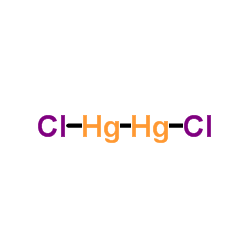Mercury(I) chloride

Mercury(I) chloride structure
|
Common Name | Mercury(I) chloride | ||
|---|---|---|---|---|
| CAS Number | 10112-91-1 | Molecular Weight | 472.086 | |
| Density | 7.15 | Boiling Point | N/A | |
| Molecular Formula | Cl2Hg2 | Melting Point | 400 °C (subl.)(lit.) | |
| MSDS | Chinese USA | Flash Point | N/A | |
| Symbol |



GHS07, GHS08, GHS09 |
Signal Word | Danger | |
| Name | dimercury dichloride |
|---|---|
| Synonym | More Synonyms |
| Density | 7.15 |
|---|---|
| Melting Point | 400 °C (subl.)(lit.) |
| Molecular Formula | Cl2Hg2 |
| Molecular Weight | 472.086 |
| Exact Mass | 473.878906 |
| LogP | 1.37400 |
| InChIKey | ZOMNIUBKTOKEHS-UHFFFAOYSA-L |
| SMILES | Cl[Hg].Cl[Hg] |
CHEMICAL IDENTIFICATION
HEALTH HAZARD DATAACUTE TOXICITY DATA
|
| Symbol |



GHS07, GHS08, GHS09 |
|---|---|
| Signal Word | Danger |
| Hazard Statements | H302 + H312-H315-H319-H334-H335-H410 |
| Precautionary Statements | P261-P280-P284-P304 + P340-P305 + P351 + P338-P342 + P311 |
| Hazard Codes | Xn:Harmful;N:Dangerousfortheenvironment; |
| Risk Phrases | R22;R36/37/38;R50/53 |
| Safety Phrases | S13-S24/25-S46-S60-S61 |
| RIDADR | UN 2811 6.1/PG 3 |
| WGK Germany | 3 |
| RTECS | OV8740000 |
| Packaging Group | II |
| Hazard Class | 6.1 |
|
A highly selective and simple fluorescent sensor for mercury (II) ion detection based on cysteamine-capped CdTe quantum dots synthesized by the reflux method.
Luminescence 30(4) , 465-71, (2015) Cysteamine (CA)-capped CdTe quantum dots (QDs) (CA-CdTe QDs) were prepared by the reflux method and utilized as an efficient nano-sized fluorescent sensor to detect mercury (II) ions (Hg(2+) ). Under ... |
|
|
Mercury-induced dysfunctions in multiple organelles leading to cell death.
Toxicol. In Vitro 29(1) , 63-71, (2014) Mercury (Hg) is a highly toxic metal that can exert multiple adverse effects, ultimately leading to cell death. Before causing death, the Hg enters the cells and affects diverse intracellular targets.... |
|
|
The degradation behaviour of nine diverse contaminants in urban surface water and wastewater prior to water treatment.
Environ. Sci. Process. Impacts 17 , 2051-65, (2015) An increasing diversity of emerging contaminants are entering urban surface water and wastewater, posing unknown risks for the environment. One of the main contemporary challenges in ensuring water qu... |
| dichlorodimercure(Hg-Hg) |
| Mercurous chloride |
| calomel |
| Dichlordiquecksilber(Hg-Hg) |
| MERCURY CHLORIDE |
| Mercury(I) Chloride, Acs Min |
| MFCD00011043 |
| EINECS 233-307-5 |
| Mercury, dichlorodi-, (Hg-Hg) |
| Hg2Cl2 |
| Dichlorodimercury(Hg-Hg) |
| Mercuric chloride |
| Mercury(I) chloride |